In the middle of winter, Crete is not easy to escape from. Flights don't leave in gale-force winds, while the ferry boat may remain tied up in the harbour for up to three days if the weather is bad. Entertainment usually consists of staying at home and watching television, visiting friends, and going out for drinks and dinner. It's very much an indoor culture, until the damp cold weather slowly gives way to spring and Easter time. The natural borders of Crete make the island a very small place to live in at times. One of the few outdoor venues for entertainment in Hania is the Omalos plateau, both for its snow and its pristine natural landscape. Given its proximity to the main town, it has become a magnet for attracting both the local and the foreign tourist for alternative Cretan sightseeing and eco-tourism.
The Omalos plateau below the Lefka Ori mountain range was not connected by road traffic to the last inhabited mountain village (Lakki) until the 1950s. Up until then, apart from its use as a hideout by the resistance groups against the Ottomans and Nazis, it was also used mainly by local shepherds and hunters. It was also discovered by the few daring Westerners who travelled through it before there were any facilities built to cater for them. Olive cultivation is difficult on the plateau because of the heavy winters that this area experiences - it always snows heavily here at least twice in the winter.
Despite its remoteness and inhospitable climate in the colder months, the plateau and its surrounding hillsides do manage to produce high quality fresh produce. Shepherds bring their flocks here to graze all year round, moving them only when snow is forecast. Shepherds may also maintain a shed and stone mountain hut (called 'mitato') for cheesemaking. It is too laborious to transport the milk to lower ground after milking sheep and goats, so most of Crete's cheese production is undertaken in the areas where the animals graze and shelter.

Remains of an old aloni on the Omalos plateau. Every step you take on this field stamps on a wild edible green.
In the past, wheat was grown in the fertile valley, but now only the dugout can be seen where wheat was ground, using horses and donkeys walking round the aloni where two round stones, one on top of the other (unlike for olive grinding where the stones were upright), ground the wheat, turning it into flour. One form of cultivation that does seem to thrive is apple trees. There are a number of fields covered in bare trees in winter. The apple season is long over by the time the snow makes its first appearance.
Another gem in this wilderness is the abundance of wild leafy greens that grow in the valley. Wild leafy greens, the most highly valued edibles, grow profusely throughout the Cretan countryside, with very little help from human beings, being nurtured simply by the natural elements of the sun and rain. But mountain-grown greens are more prized than greens cultivated in lower regions. For a start, they receive natural fertilisation without any chemical additives and they are never irrigated apart from rain water. Wild greens which have been harvested from such areas are sold for higher prices at fresh produce counters than cultivated greens.
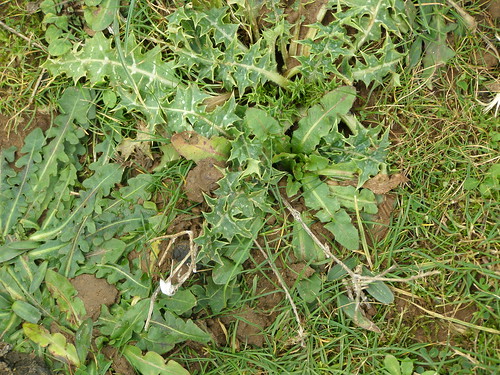
Wild leafy greens: maroulides on the left (the ones that look like dandelion greens), stamnagathi at the bottom (with the woody thorns) and ascolibri at the top (the thorny leaves with spikes). Can you see the natural fertiliser?
The term 'horta' is applied generally to all leafy greens which grow in the wild and are collected in their natural habitats, as well as those that are being cultivated, having been originally found in the wild, such as amaranth. The word 'horta' (χόρτα) means 'grass', which is pretty much what horta look like before they are presented on a plate. The way people found out that these wild leafy greens were edible is complicated. Survival instincts, the need to feed and be fed, copying animals' eating habits, as well as a bit of trial and error, all played their role.
On our recent 'trip' to Omalos (a thirty-minute car journey), we decided to do some foraging for wild leafy greens on the fields of the plateau. Sounds illegal? Don't worry, it's not; judging by the number of people engaged in this activity the day we were up there ourselves, it seemed like good value entertainment. Maybe it sounds unethical, moving plants from their natural habitat, a bit like raping the countryside. Well, if we didn't move them, somebody else would have, and they would have sold it and made a profit from it, too. In any case, we were only taking what we could eat, with the intention of supplanting any roots in our own garden, which is a common practice.
We decided to seek out a quieter spot in amongst the foragers and revellers at Omalos. The Lefka Ori mountain range belongs to different districts in Hania. Depending on which side you are on, the fields at the foothills of the mountains belong to various districts. Taking a side turn on the main road where the hotels and restaurants are located (on the Xyloskala road), we turned into the small housing settlement on Omalos, known as the Seliniotiko yiro (named after the district is belongs to, Selino) where some of the owners of the land parcels have built summer cottages, winter retreats and shepherds' huts to overnight when they are in the area, passing by a very picturesque lake located in the middle of the valley. In more recent years, these roughshod dwellings became larger to accommodate more people like tourists and hunters (hare, partridges, turtledoves, and other small birds can be found here).

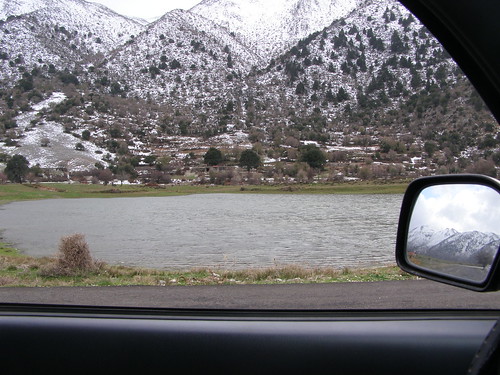
The small housing settlement on the Omalos plateau; the lake is visible on the google map.
Here's the story I've heard about how this house got to this state. About 45-50 years ago, Mr A (the owner of the house, which was also a kind of bed and breakfast with a cafe operating on the ground floor) and Mr B were involved in shady dealings (they were growing other kinds of 'horta'), whose profits were shared among them. One of these deals didn't go as planned. Mr A questioned Mr B about his share of the profits. Mr B admitted that he had made a mistake in his calculations, and that he'd go to his car and get more money to give to Mr A. Mr A was watching Mr B as he went to his car. As Mr B walked back to Mr A, Mr A noticed that he was carrying a gun. At that moment, Mr A took out his gun (he was also carrying one), shot Mr B dead, took his wife and kids and left Crete forever, fearing a vendetta, which is clearly how this matter developed, since his house, cafe and guest rooms were blown up. Rumour has it that he went to the USA...
A wild story to match the wild greens we were about to harvest.
Omalos and the foothills of the Lefka Ori are the home environment of some of the tastiest wild leafy greens found in Crete: stamnagathi (Chicorum spinosum), maroulides (a kind of dandelion) and ascolibri (Scolymus hispanicus).
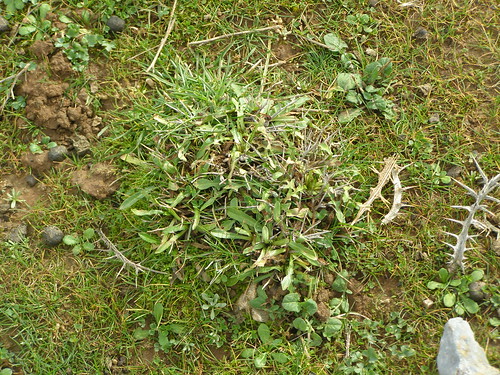
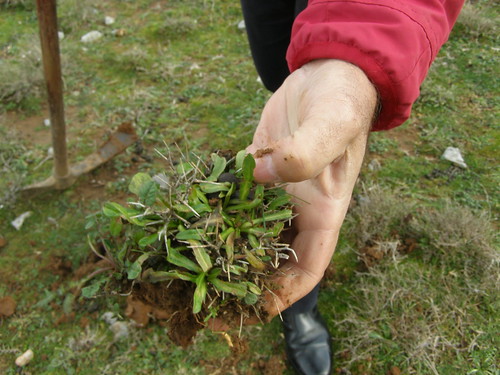
Wild stamnagathi in its natural habitat; it's like an urn (στάμνα - stamna) in amongst thorns (αγκάθια - agathia). If you see it close-up, you'll get a glimpse of its 'natural fertilisation'.
Cultivated stamnagathi (sown by seed) and ascrolibri in their cooked form

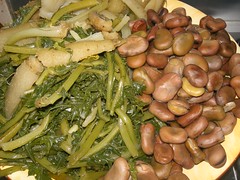
And here are our finds in an orange crate, ready to be transported home...
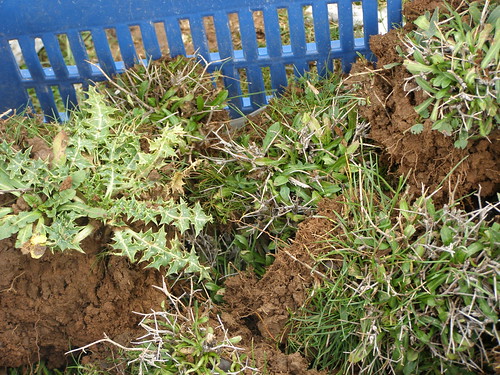
... and transplanted to a new patch of earth, our garden.

*** *** ***
On our recent 'trip' to Omalos (a thirty-minute car journey), we decided to do some foraging for wild leafy greens on the fields of the plateau. Sounds illegal? Don't worry, it's not; judging by the number of people engaged in this activity the day we were up there ourselves, it seemed like good value entertainment. Maybe it sounds unethical, moving plants from their natural habitat, a bit like raping the countryside. Well, if we didn't move them, somebody else would have, and they would have sold it and made a profit from it, too. In any case, we were only taking what we could eat, with the intention of supplanting any roots in our own garden, which is a common practice.
We decided to seek out a quieter spot in amongst the foragers and revellers at Omalos. The Lefka Ori mountain range belongs to different districts in Hania. Depending on which side you are on, the fields at the foothills of the mountains belong to various districts. Taking a side turn on the main road where the hotels and restaurants are located (on the Xyloskala road), we turned into the small housing settlement on Omalos, known as the Seliniotiko yiro (named after the district is belongs to, Selino) where some of the owners of the land parcels have built summer cottages, winter retreats and shepherds' huts to overnight when they are in the area, passing by a very picturesque lake located in the middle of the valley. In more recent years, these roughshod dwellings became larger to accommodate more people like tourists and hunters (hare, partridges, turtledoves, and other small birds can be found here).


The small housing settlement on the Omalos plateau; the lake is visible on the google map.
As you pass by the houses, you come across one that looks as though it did not survive an earthquake well. The first floor looks buckled like the motorways after a sever case of seismic activity in Japan and California, while the rooms hang lopsided over the shelled-out cavity below. The neighbours' houses, however, haven't suffered any damage whatsoever.
Here's the story I've heard about how this house got to this state. About 45-50 years ago, Mr A (the owner of the house, which was also a kind of bed and breakfast with a cafe operating on the ground floor) and Mr B were involved in shady dealings (they were growing other kinds of 'horta'), whose profits were shared among them. One of these deals didn't go as planned. Mr A questioned Mr B about his share of the profits. Mr B admitted that he had made a mistake in his calculations, and that he'd go to his car and get more money to give to Mr A. Mr A was watching Mr B as he went to his car. As Mr B walked back to Mr A, Mr A noticed that he was carrying a gun. At that moment, Mr A took out his gun (he was also carrying one), shot Mr B dead, took his wife and kids and left Crete forever, fearing a vendetta, which is clearly how this matter developed, since his house, cafe and guest rooms were blown up. Rumour has it that he went to the USA...
A wild story to match the wild greens we were about to harvest.
*** *** ***
We found the perfect spot: the field was located beyond the old housing settlement, near some newly constructed holidays homes. Most properties on Omalos are made from stone, which is also found in great abundance in amongst the fields surrounding these new houses, so they could be said to have been built with fewer carbon footprints than what it normally take sto build a house. These homes were all empty on the day we visited, but it looks as though they are being built as mainly summer cottages with wide verandahs.
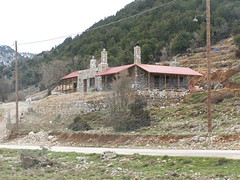

Some houses are new, while others are built next to old rundown derelict huts.
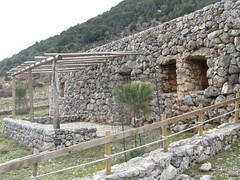
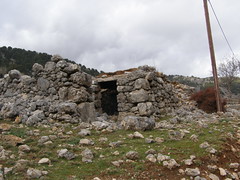
The newer construction on the right is built right next to the rundown hut, sharing a wall.
The fields across the road from these houses were empty, apart from the remains of the aloni, and a few other foragers like ourselves.


Some houses are new, while others are built next to old rundown derelict huts.


The newer construction on the right is built right next to the rundown hut, sharing a wall.
The fields across the road from these houses were empty, apart from the remains of the aloni, and a few other foragers like ourselves.
Omalos and the foothills of the Lefka Ori are the home environment of some of the tastiest wild leafy greens found in Crete: stamnagathi (Chicorum spinosum), maroulides (a kind of dandelion) and ascolibri (Scolymus hispanicus).


Wild stamnagathi in its natural habitat; it's like an urn (στάμνα - stamna) in amongst thorns (αγκάθια - agathia). If you see it close-up, you'll get a glimpse of its 'natural fertilisation'.


And here are our finds in an orange crate, ready to be transported home...

... and transplanted to a new patch of earth, our garden.

The last time we transplanted stamnagathi, it took a year to grow to a decent sized bush, and it gave us about a one serving each - before it was uprooted by someone who didn't realise it wasn't a weed (a Bulgarian live-in nurse; she was only trying to help us clean up our yard... Our wild greens need about two years to grow, seed and re-grow before we can expect to get a decent meal out of them; for the time being, they make an attractive border to the driveway.
And that's the end of our adventures for this year at the Omalos plateau.
©All Rights Reserved/Organically cooked. No part of this blog may be reproduced and/or copied by any means without prior consent from Maria Verivaki.

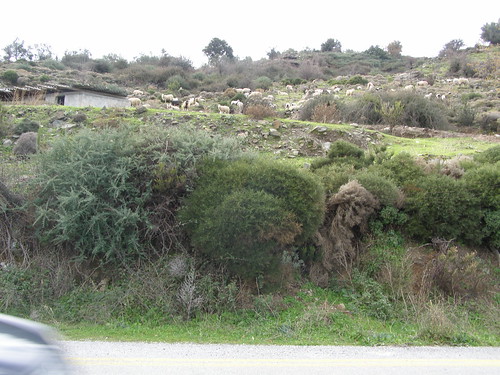

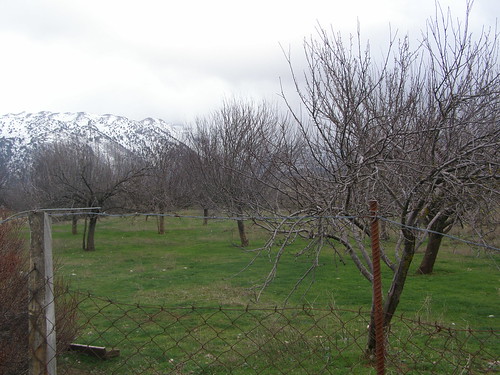




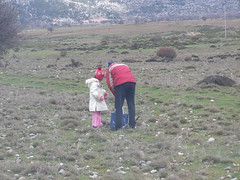
I hope you have better luck!
ReplyDeleteFirst, I love the little beanie on top of your daughter's hat! Next, the landscape looks so rugged. It made me wonder how the ancient Greeks got around. The culinary value of those greens is something new to me. I'd have no idea what to look for. How wonderful that your kids went with you so they'll have that knowledge, too. I winced when I read about your other plants being accidentally pulled. Hope these plant grow strong and give you many servings of greens.
ReplyDeleteYou do live in such a beautiful place! It looks so lovely - I'm really very jealous :)
ReplyDeleteLovely pictures of the Omalos plateau. Oh, I don't think there's anything wrong with pulling those weeds from the Omalos and bring them home. The weeds will eventually grow again! You can't get fresher than that!
ReplyDeleteGreat post! Thanks for participating in WHB!
ReplyDeleteMorning Maria, how's the other side of the island? This side is basking in some really lovely warm days at the moment.
ReplyDeleteOne question, how do you cure your olives? I've used a different recipe each year, some good, some awful (too salty last year)
I am going to do a post about it in the next couple of days, weeks.
Take care
Jude
Picking wild horta must be so much fun! I hope it's not too freezing!
ReplyDeleteHow healthy is this? A rigorous walk in the hills, picking horta and then incorporating them in healthy dishes?
ReplyDeleteMy kingdom for a plate of wild greens from Omalos!!!
ReplyDeletethanks for taking us through the adventures of the Omalos Plateau and serving the unique wild green:)
ReplyDeleteI love you photos! The kids seemed to ha ve a lot of fun running around out there.
ReplyDeleteMIL was here over the weekend and once again lectured me about how much horta I have on my property...I just don't eat it. But anyone that I know is always welcome to take what they gather!! She left with a huge sack for her and friends.
Hi Maria,
ReplyDeleteI think that eating the wild greens makes one able to endure the rugged climate. Nice that the people there appreciate this and will even pay more because they see the difference. Thanks for another incredible post. I loved it. Makes me want to grow horta (the edible one!) again.